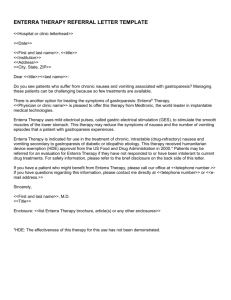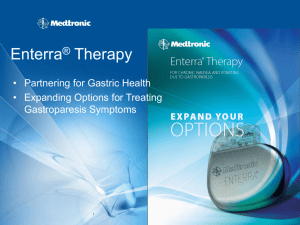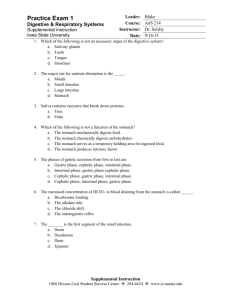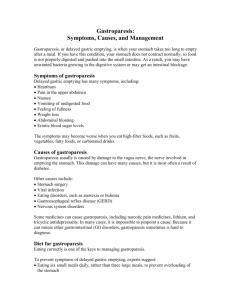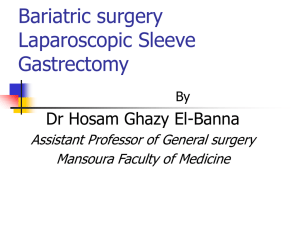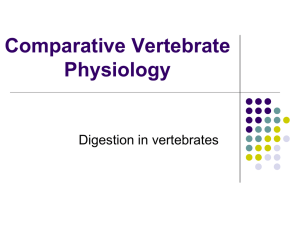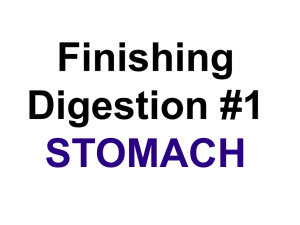Laparoscopic Placement of Gastric Electro Stimulator
advertisement
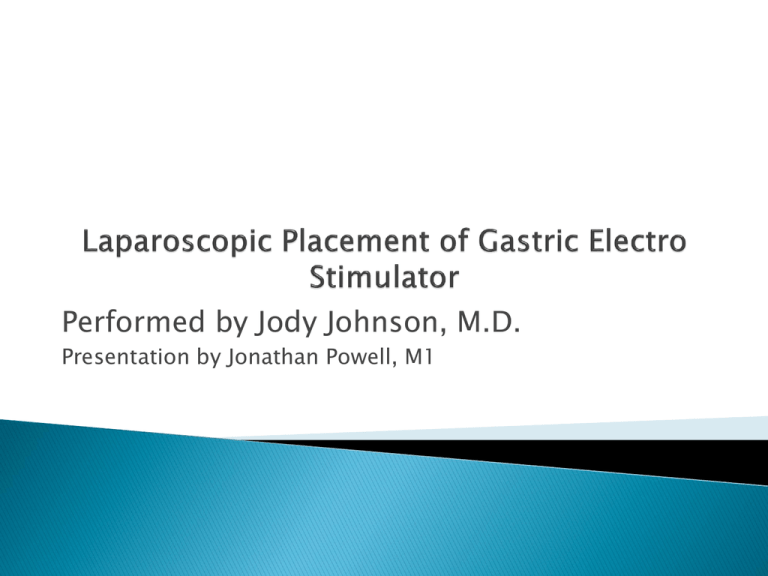
Performed by Jody Johnson, M.D. Presentation by Jonathan Powell, M1 Female Type 1 diabetes has lead to peripheral neuropathy ◦ Resulted in gastroparesis Peripheral neuropathy: In this case the patient has diabetic peripheral neuropathy in which the high blood sugar levels damaged her peripheral nerves ◦ Can cause pain (or sometimes lack of sensation) and loss of motor control A stomach disorder in which a full thickness loss of cells of Cajal (neuroconducting cells of the stomach) leads to a decrease in gastric emptying Stomach muscles function poorly ◦ Food digested slowly, results in a lot of pain Common causes: ◦ Idiopathic in most cases ◦ Type 1 or 2 diabetes Proper nutrition/diet changes: restrict fats, frequent but small meals, lots of fluids Drugs: ◦ Prokinetic: improve rate of stomach emptying ex. Methylnaltrexone ◦ Antiemetic: control nausea and vomiting, no effect of stomach emptying ex. Prochlorperazine Surgery: the last resort ◦ Pyroplasty: widening of pyloric valve ◦ Gastric ESTIM Enterra neurostimulator implanted beneath the skin Anode and cathode implanted in wall of stomach along the Greater Curvature Handheld programming device is used to alter the degree and frequency of stimulation (catered to each patient) Effectiveness has not been demonstrated Patient Position Scissors Marilyn dissector O-suture 3-O silk R01 Suture Debakey Enterra neurostimulator Two trochars (size 5) One trochar (size 10) Laparoscope Hand held programming device to set frequency and degree of current discharge by the device Equipment Used Initial incisions: one midline incision between abdominal quadrants one and two for placement of scope Two lateral incisions for size 5 trochars (5s are free) ◦ One in each abdominal quadrant ID the pylorus Deflate stomach Mark point 10cm along Greater Curve of Stomach starting from pylorus Insert leads into stomach wall ◦ Caudal lead at 9.5cm from pylorus ◦ Rostral lead at 10.5 cm from pylorus Make pocket at Left midquadrant for subcutaneous placement of battery Externalize leads Close up Interrogation: device that, when placed above ESTIM site, can be used to measure battery life and set the current released during each discharge of the device Patient can be sent home that day Possible complications: ◦ Pain, lack of healing, or infection where device was implanted ◦ Parts of device could wear through skin ◦ Allergic rxn to device ◦ Leads may perforate your stomach or device components may become entangled with or obstruct other internal organs ◦ Tissue damage from improper stimulation setting or malfunction Gastric ESTIM is no longer being performed because the effectiveness of this procedure could not be demonstrated Currently, ESTIM procedures are used for maladies such as: ◦ Xerostomia- dry mouth due to lack of saliva Intraoral electrostimulation device increases salivary output of Parotid Gland ◦ Function electrical stimulation- use electrical stimulation to activate peripheral nerves affected by paralysis from spinal cord injury, head injury, stroke, etc Sometimes referred to as neuromuscular electrical stimulation Buckles, MD, Daniel, Jameson Forster, MD, and Richard McCallum, MD. "The Treatment of Gastroparesis in the Age of the Gastric Pacemaker: A Review." Medscape 5.4 (2003): 6. Web. 15 Apr 2011. <http://www.medscape.com/viewarticle/460632>. "About Gastroparesis." Medtronic. Medtronic Inc., 22 09 2010. Web. 15 Apr 2011. <http://www.medtronic.com/your-health/gastroparesis/index.htm>. McCallum, MD, Richard, William Snape, MD, Fredrick Brody, MD, and John Wo, MD. "Gastric Electrical Stimulation With Enterra Therapy Improves Symptoms From Diabetic Gastroparesis in a Prospective Study." Clinical Gastroenterology andHepatology 8.11 (2010): 947-954.e1. Web. 15 Apr 2011. <http://www.cghjournal.org/article/s1542-3565(10)005458/abstract>. Douglas, David. "Electrostimulation Relieves Xerostomia." Medscape News (2010): n. pag. Web. 15 Apr 2011.< http://www.medscape.com/viewarticle/731503>. Abell, MD, Thomas. "Gastric Electrical Stimulation for Medically Refractory Gastroparesis." University of California San Francisco. University of California San Francisco College of Medicine, 2003. Web. 15 Apr 2011. <http://sadieo.ucsf.edu/course/old/Abell1.pdf>.



